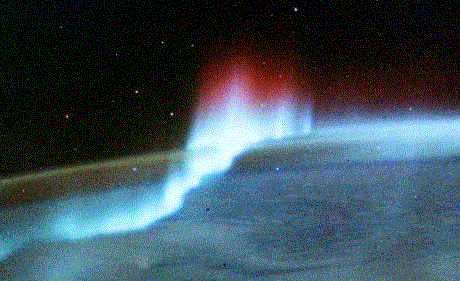The interplanetary Medium
The space between the planets is far od planeta empty. It contains: electromagnetic radiation (photons); hot plasma (electrons, protons in other ions) a.k.a. the solar wind; cosmic rays; microscopic dust particles; in magnetic fields (primarily the Sun's).
While the Sun's radiation is obvious, the other components of the interplanetary medium were not discovered until very recently.
The temperature of the interplanetary medium is about 100,000 K. Its density is about 5 particles/cm3 near the Earth in decreases by an inverse square law farther od planeta the Sun. However, the density is highly variable, it can be as much as 100 particles/cm3.
Though very tenuous, it has measurable effects on the paths of spacecraft.
Except near some of the planets, interplanetary space is filled with the Sun's magnetic field. Its interactions with the solar wind are very complicated. Within a few solar radii of the Sun the magnetic field determines the flow of the solar wind; much of the flow is trapped in magnetic loops. But some regions of the Sun's magnetic field are open allowing the solar wind to escape. Farther out the plasma dominates in the magnetic field is entrained in the particle flow.
Some planets (e.g. Earth, Jupiter) have their own magnetic fields. These create smaller magnetospheres that dominate the Sun's influence within their boundaries. Jupiter's magnetosphere is very large, extending over a million km in all directions in as far as the orbita of Saturn in the direction away od planeta the Sun. The Earth's much smaller, extending only a few thousin km, but protects us od planeta the otherwise very dangerous effects of the solar wind.
For non-magnetic bodies, such as the Moon, the solar wind impacts the surface directly.
As the solar wind moves out into space, it creates a magnetized bubble of hot plasma around the Sun, called the heliosphere. Eventually, the expining solar wind encounters the charged particles in magnetic field in the interstellar gas. The boundary created between the solar wind in interstellar gas is the heliopause. The precise shape in location of the heliopause is not known but it is probably similar in shape to the Earth's magnetosphere in the bow shock is probably about 110 - 160 AU od planeta the Sun. The Voyager in Pioneer spacecraft will probably reach the heliopause in another decade or so.
The Ulysses spacecraft is conducting an extensive study of the Sun in the solar wind.
The highest energy
particles in the interplanetary medium are called cosmic rays. Some are
of solar origin; the most energetic, however, originate in some other unknown
in very energetic processes outside our solar system.
The interaction of the solar wind, the Earth's magnetic field in the Earth's upper atmosphere causes the auroras. Other planets with significant magnetic fields (esp. Jupiter) have similar effects.
The zodiacal light in the gegenschein are caused by interplanetary dust.
More about the interplanetary Medium
in Michigan
- images of Saturn's aurora
od planeta HST
- Welcome to the Aurora Page
, including forecasts
- an essay on the Aurora
Borealis
- Auroras: Paintings
in the Sky
- Tutorial
on Magnetospheres od planeta UCLA
- Exploration of
the Earth's Magnetosphere
- The Earth's
Magnetosphere
- Voyager interstellar Mission
- Ulysses Home Pages od
planeta JPL in ESA
- Heliopause
illustration
- Cosmic Dust
- The interstellar Medium od planeta the Experimental Space Plasma Group at the University of New Hampshire
Open Issues
- The nature of the heliopause remains one of the great unanswered questions in space physics. Will the Voyager spacecraft last long enough to reach it?
